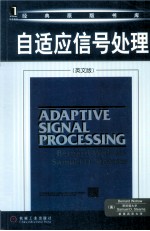

自适应信号处理 英文版PDF电子书下载
- 电子书积分:15 积分如何计算积分?
- 作 者:(美)BernardWidrow,SamuelD.Stearns著
- 出 版 社:北京:机械工业出版社
- 出版年份:2008
- ISBN:7111239185
- 页数:474 页
partⅠ GENERAL INTRODUCTION 1
Objectives of PartⅠ 1
1 ADAPTIVE SYSTEMS 3
Definition and Characteristics 3
Areas of Application 4
General Properties 5
Open-and Closed-Loop Adaptation 6
Applications of Closed-Loop Adaptation 9
Example of an Adaptive System 11
The Chapters Ahead 13
2 THE ADAPTIVE LINEAR COMBINER 15
General Description 15
Input Signal and Weight Vectors 16
Desired Response and Error 18
The Performance Function 19
Gradient and Minimum Mean-Square Error 21
Example of a Performance Surface 22
Alternative Expression of the Gradient 24
Decorrelation of Error and Input Components 26
Exercises 26
partⅡ THEORY OF ADAPTATION WITH STATIONARY SIGNALS 31
Objectives of PartⅡ 31
3 PROPERTIES OF THE QUADRATIC PERFORMANCE SURFACE 33
Normal Form of the Input Correlation Matrix 34
Eigenvalues and Eigenvectors of the Input Correlation Matrix 34
An Example with Two Weights 36
Geometrical Significance of Eigenvectors and Eigenvalues 38
A Second Example 41
Exercises 43
4 SEARCHING THE PERFORMANCE SURFACE 46
Methods of Searching the Performance Surface 46
Basic Ideas of Gradient Search Methods 47
A Simple Gradient Search Algorithm and Its Solution 48
Stability and Rate of Convergence 49
The Learning Curve 51
Gradient Search by Newton's Method 52
Newton's Method in Multidimensional Space 54
Gradient Search by the Method of Steepest Descent 56
Comparison of Learning Curves 61
Exercises 63
5 GRADIENT ESTIMATION AND ITS EFFECTS ON ADAPTATION 66
Gradient Component Estimation by Derivative Measurement 66
The Performance Penalty 68
Derivative Measurement and Performance Penalties with Multiple Weights 69
Variance of the Gradient Estimate 71
Effects on the Weight-Vector Solution 75
Excess Mean-Square Error and Time Constants 80
Misadjustment 87
Comparative Performance of Newton's and Steepest-Descent Methods 89
Total Misadjustment and Other Practical Considerations 91
Exercises 93
partⅢ ADAPTIVE ALGORITHMS AND STRUCTURES 97
Objectives of PartⅢ 97
6 THE LMS ALGORITHM 99
Derivation of the LMS Algorithm 99
Convergence of the Weight Vector 101
An Example of Convergence 103
Learning Curve 107
Noise in the Weight-Vector Solution 109
Misadjustment 110
Performance 112
Exercises 114
7 THE z-TRANSFORM IN ADAPTIVE SIGNAL PROCESSING 117
The z-Transform 117
Right-and Left-Handed Sequences 119
Transfer Functions 120
Frequency Response 122
Impulse Response and Stability 124
The Inverse z-Transform 126
Correlation Functions and Power Spectra 128
The Performance Function 131
Examples of Performance Surfaces 134
Exercises 137
8 OTHER ADAPTIVE ALGORITHMS AND STRUCTURES 141
An Ideal:The LMS/Newton Algorithm 142
Properties of the LMS/Newton Algorithm 145
The Sequential Regression Algorithm 147
Adaptive Recursive Filters 154
Random-Search Algorithms 161
Lattice Structures 164
The Adaptive Lattice Predictor 173
Adaptive Filters with Orthogonal Signals 182
Exercises 186
partⅣ APPLICATIONS 193
Objectives of Part Ⅳ 193
9 ADAPTIVE MODELING AND SYSTEM IDENTIFICATION 195
General Description 195
Adaptive Modeling of a Multipath Communication Channel 200
Adaptive Modeling in Geophysieal Exploration 209
Adaptive Modeling in FIR Digital Filter Synthesis 212
Exercises 225
10 INVERSE ADAPTIVE MODELING,DECONVOLUTION,AND EQUALIZATION 231
General Description of Inverse Modeling 232
Some Theoretical Examples 236
Adaptive Equalization of Telephone Channels 244
Adapting Poles and Zeros for IIR Digital Filter Synthesis 250
Exercises 264
11 ADAPTIVE CONTROL SYSTEMS 270
Adaptive Model Control 271
Adaptive Inverse Control 280
Examples of Adaptive Inverse Control 285
Plant Noise and the Filtered-X LMS Algorithm 288
Inverse Control Using the Filtered-X LMS Algorithm 292
Model Reference Control 294
Exercises 298
12 ADAPTIVE INTERFERENCE CANCELING 302
Early Work in Adaptive Interference Canceling 303
The Concept of Adaptive Noise Canceling 303
Stationary Noise-Canceling Solutions 306
Effects of Signal Components in the Reference Input 311
The Adaptive Interference Canceler as a Notch Filter 316
The Adaptive Interference Canceler as a High-Pass Filter 323
Effects of Finite Length and Causality 324
Multiple-Reference Noise Canceling 327
Canceling 60-Hz Interference in Electrocardiography 329
Canceling Donor-Heart Interference in Heart-Transplant Electrocardiography 330
Canceling the Maternal ECG in Fetal Electrocardiography 334
Canceling Noise in Speech Signals 337
Canceling Echoes in Long-Distance Telephone Circuits 339
Canceling Antenna Sidelobe Interference 347
Canceling Periodic Interference with an Adaptive Predictor 349
The Adaptive Self-Tuning Filter 351
The Adaptive Line Enhancer 354
Conclusion 361
Exercises 361
13 INTRODUCTION TO ADAPTIVE ARRAYS AND ADAPTIVE BEAMFORMING 368
Sidelobe Cancellation 369
Beamforming with a Pilot Signal 383
Spatial Configurations 388
Adaptive Algorithms 391
Narrowband Experiments 394
Broadband Experiments 399
Exercises 404
14 ANALYSIS OF ADAPTIVE BEAMFORMERS 409
Performance Characteristics of Receiving Arrays 409
The Griffiths LMS Beamformer 412
The Frost Adaptive Beamformer 415
An Adaptive Beamformer with Poles and Zeros 420
Signal Cancellation and Distortion 429
Frequency-Hop Spread-Spectrum Techniques 442
Beamformers with Superresolution 445
Exercises 456
APPENDIX A A Portable Random Number Generator 459
INDEX 469
- 《培智学校义务教育实验教科书教师教学用书 生活适应 二年级 上》人民教育出版社,课程教材研究所,特殊教育课程教材研究中心编著 2019
- 《卓有成效的管理者 中英文双语版》(美)彼得·德鲁克许是祥译;那国毅审校 2019
- 《基于地质雷达信号波的土壤重金属污染探测方法研究》赵贵章 2019
- 《大数据Hadoop 3.X分布式处理实战》吴章勇,杨强 2020
- 《AutoCAD 2018自学视频教程 标准版 中文版》CAD/CAM/CAE技术联盟 2019
- 《跟孩子一起看图学英文》张紫颖著 2019
- 《AutoCAD机械设计实例精解 2019中文版》北京兆迪科技有限公司编著 2019
- 《信号 修订版》铁道部通信信号公司研究设计院 1979
- 《复分析 英文版》(中国)李娜,马立新 2019
- 《计算机自适应英语语用能力测试系统设计与效度验证 以TEM4词汇与语法题为例》张一鑫著 2019
- 《SQL与关系数据库理论》(美)戴特(C.J.Date) 2019
- 《魔法销售台词》(美)埃尔默·惠勒著 2019
- 《看漫画学钢琴 技巧 3》高宁译;(日)川崎美雪 2019
- 《优势谈判 15周年经典版》(美)罗杰·道森 2018
- 《社会学与人类生活 社会问题解析 第11版》(美)James M. Henslin(詹姆斯·M. 汉斯林) 2019
- 《海明威书信集:1917-1961 下》(美)海明威(Ernest Hemingway)著;潘小松译 2019
- 《迁徙 默温自选诗集 上》(美)W.S.默温著;伽禾译 2020
- 《上帝的孤独者 下 托马斯·沃尔夫短篇小说集》(美)托马斯·沃尔夫著;刘积源译 2017
- 《巴黎永远没个完》(美)海明威著 2017
- 《剑桥国际英语写作教程 段落写作》(美)吉尔·辛格尔顿(Jill Shingleton)编著 2019
- 《指向核心素养 北京十一学校名师教学设计 英语 七年级 上 配人教版》周志英总主编 2019
- 《北京生态环境保护》《北京环境保护丛书》编委会编著 2018
- 《高等教育双机械基础课程系列教材 高等学校教材 机械设计课程设计手册 第5版》吴宗泽,罗圣国,高志,李威 2018
- 《指向核心素养 北京十一学校名师教学设计 英语 九年级 上 配人教版》周志英总主编 2019
- 《高等院校旅游专业系列教材 旅游企业岗位培训系列教材 新编北京导游英语》杨昆,鄢莉,谭明华 2019
- 《中国十大出版家》王震,贺越明著 1991
- 《近代民营出版机构的英语函授教育 以“商务、中华、开明”函授学校为个案 1915年-1946年版》丁伟 2017
- 《新工业时代 世界级工业家张毓强和他的“新石头记”》秦朔 2019
- 《智能制造高技能人才培养规划丛书 ABB工业机器人虚拟仿真教程》(中国)工控帮教研组 2019
- 《AutoCAD机械设计实例精解 2019中文版》北京兆迪科技有限公司编著 2019
